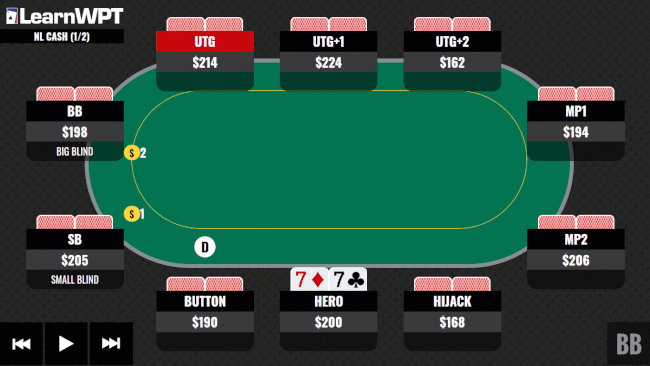7♦7♣ on the River, what do you do here?
DECISION POINT: In a live $1-2 game action folds to you in the Cutoff and you raise to $6 with 7♦7♣. The Button and Small Blind fold and the Big Blind calls. You bet $10 into the checked 2♠8♥9♦ flop and the BB calls. After you both check the 3♠ turn, Villain bets $22 on the 9♠ river and action is on you. What do you do here?
PRO ANSWER: We are playing in a cash game with a standard 3BB raise size. It folds to us in the Cutoff with 7d7c and we raise to $6. Everyone folds to the Big Blind who flat calls.
The flop is 2s8h9d and our opponent checks to us. This is the type of flop that connects with our opponent’s range quite well, which includes several A9o/T9s/T8s/JT/QJ type hands with a lot of equity that won’t fold to a continuation bet.
Our particular hand, pocket sevens, benefits when our opponent folds some random over cards such as KJo. Against tough players the appropriate strategy is somewhat mixed here between betting large, betting small, and checking. We decide to bet on the larger side of $10 into a $13 pot and our opponent calls.
The turn is the 3s and our opponent again checks to us. Given the larger bet sizing we used on the flop our opponent’s overall range is narrower than had we either checked or bet smaller. Our hand has some showdown value but is quite unlikely to be called by a worse hand if we bet again. At this point our hand works out as either a good hand to try and get to showdown cheaply with, or a bluff catcher on the river. We elect to check.
Continued below...
The river is the 9s and our opponent bets $22 into the $33 pot. With the second 9 on the board it is less likely that our opponent called on the flop with a 9x hand, which starts to weight their hand range toward more bluffs with hands such as JT/QJ rather than made hands.
If we were against a passive opponent who was incapable of turning their missed draws into bluffs we could perhaps make an exploitative fold here.
Against tough, aggressive players, when we are calling $22 to win $55 we only need our opponent to be bluffing here around 29% of the time. In this spot our opponent should have more than enough potential bluffs in their overall range to achieve that.
Calling is the best play
How would you play it?
Share your answer in the comments below!
Improve Your Game Today!
Join LearnWPT and Get:
Think Like a Pro
- To Train and Play Hands using the WPT GTO Trainer for instant feedback on YOUR leaks
- On-demand access to in-depth Strategy Episodes
- All of your poker questions answered with the Ask a Pro Feature
- Expert analysis from LearnWPT Pros using The Hand Input Tool
- Community Forums to discuss all things poker with fellow LearnWPT Members
- Downloadable Tools you can use at and away from the tables
To join (just $5 your first month) click the white JOIN NOW button in the top corner of your screen or the button below and start improving your game!
Have Questions about LearnWPT? Email us at [email protected] and we’ll be happy to help!


